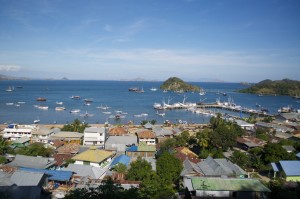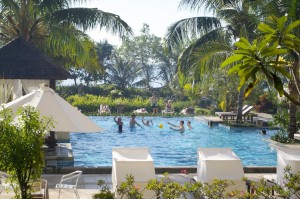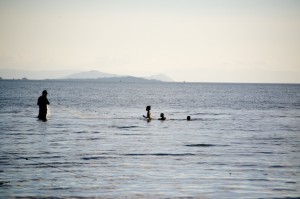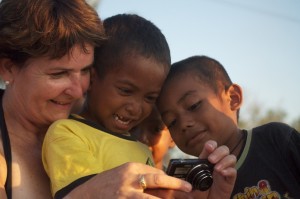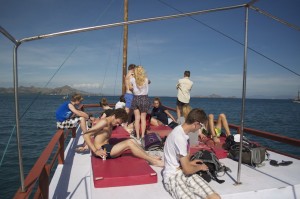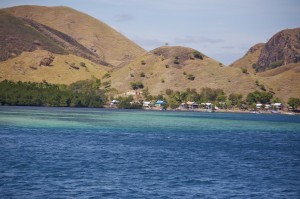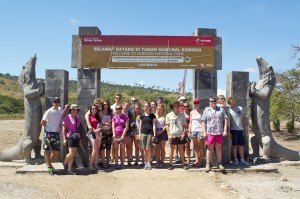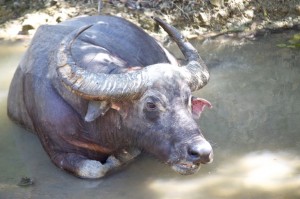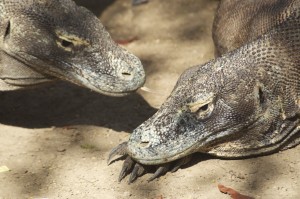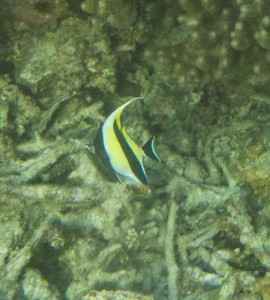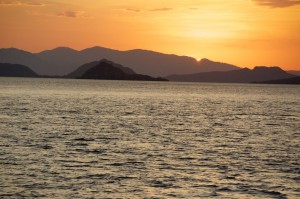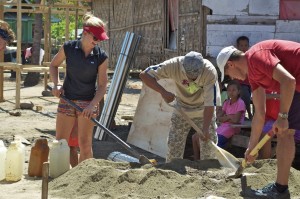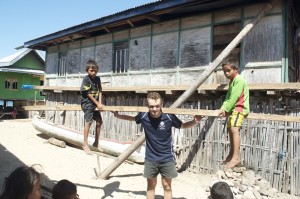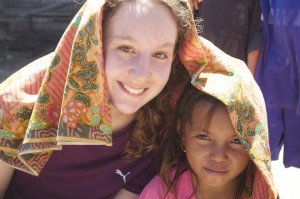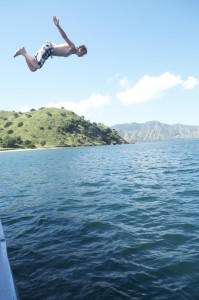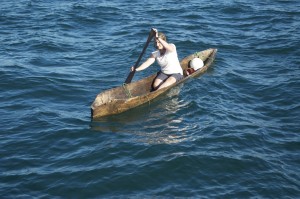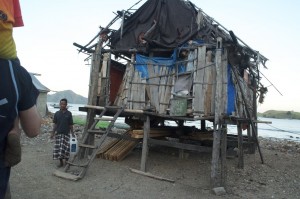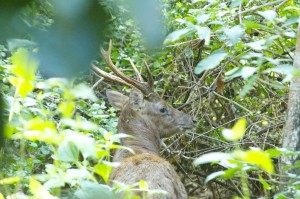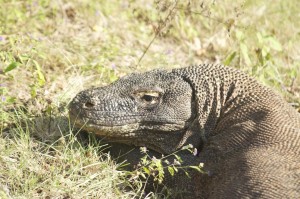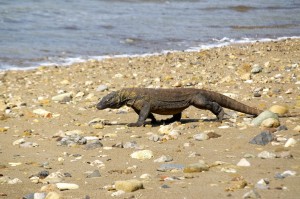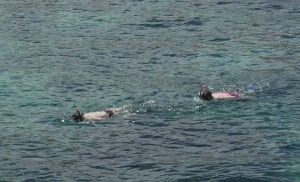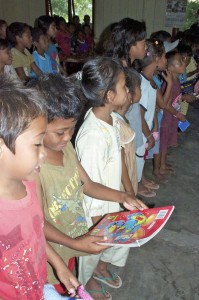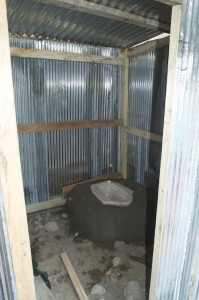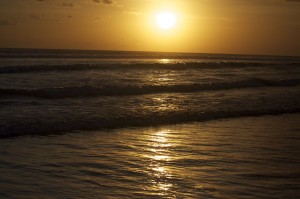Stephen had flown in from Papua the day before we arrived in Bali and he now joined us for the remainder of our time in Indonesia. We chose to eat in the hotel that evening rather than introduce the students to the nightlife that Bali has to offer. Service was very slow and we began to regret the decision. There would be time to explore Kuta Bali when we return at the end of our trip.
Having overnighted in Bali we caught an early flight to Labuan Bajo, the capital of Flores and one of the most beautiful places on earth. Perched on a hillside dropping down to the port, Labuan Bajo has a population of about 18,000 and despite its status still maintains a feeling of being a small coastal village. The view from the top of the town, overlooking the harbour to the myriad of islands beyond is stunning.
Our main guide for this leg of the adventure was Dom Bosco. I immediately took a liking to him as he was engaging, interesting and interested in us. He freely talked to the students and made them feel important to him. He was everything that our previous guide was not. We had a day and a night of luxury to look forward to as we were staying at the Jayakarta Hotel a little way out of town along the coast. The rooms were comfortable, well appointed and looked down on to well cared for gardens on one side and the pool and gardens on the other with the beach and sea just beyond. When we arrived our rooms were not ready so Dom Bosco took us to the Batu Cermin caves, an interesting cleft and series of tunnels in a rocky outcrop. The stalactites and stalagmites created interesting shapes and if you were creative in your imagination you could see several faces in them.
Back at the Jayakarta Hotel we made the most of the facilities and enjoyed strolls along the beach collecting interesting pieces of coral debris, watching the local fishermen and supping a long drink while watching the sunset.
The fishing techniques were fascinating. Along the beach there was a small creek. Three boys beat the water in the creek to frighten the fish out into the open water where their father waited with a net. While it looked impressive it was hardly productive and the boys were more inclined towards having fun rather than fishing. Another group of men. standing waste deep in the water, were having a little more success as they drove the fish into a waiting net. However, nobody was going to get fat on what they were catching.
While we were watching and taking photographs of the sunset a group of children came down to the water’s edge. On realising what we were doing they made every attempt to get themselves into our photographs. They were fun and we started to let them take pictures of themselves and show them the results. They were a happy bunch of children and, while there must be shortcomings in their life on Flores, I could not help but think that they were growing up in a fantastic part of the world.
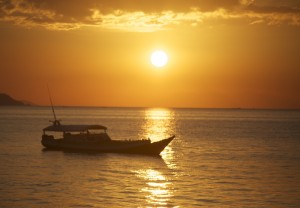 I took many shots of the sunset but think this is probably the best.
I took many shots of the sunset but think this is probably the best.
That night the hotel arranged the tables around the pool for a romantic candlelit dinner for twenty-two! the food was good, the temperature was just right and the company of twenty-two was fantastic. There was a brief interruption to the tranquility of the meal when a large crab decided to travel under the tables, between the feet on its journey to or from the sea.
The following morning we took the short drive to the harbour to board our two boats. While we would spend most of our time all travelling together on the larger boat, at night the staff would adjourn to the smaller boat moored up alongside. We quickly clambered over moored boats to board our own and no sooner were we all aboard, we were off. The students quickly positioned themselves on the open top deck to enjoy the sunshine and the views of the passing islands as we headed for Rinca.
The water was deep blue but where it was shallower the shade lightened. It was so inviting. Nowhere were we very far from land and we passed many beachside fishing communities where the houses are built on stilts. The style and design of these houses has remained the same for centuries, as have the fishing techniques the fishermen use. Nothing is done on a large scale but just sufficient for subsistent use and to sell a few at market. Behind the houses are banana trees providing fruit for the villagers. Sometimes traders in rice or vegetables visit these fishing communities and trade for fish instead of money.
After a pleasant morning sailing the blue sea we arrived at Rinca Island, the second largest island in the Komodo National Park and home to the Komodo Dragon. As we approached our mooring just away from the jetty we watched a white and grey fish eagle swoop down to the water to come up with a fish in its talons. To add to the drama a darker coloured Flores eagle harassed the fish eagle in the hope it would relinquish its catch. On the jetty we were greeted by monkeys who were keen to take food from our hands, although we advised against doing so, just in case. Around the jetty shoals of fish swarmed around the boats moored. There is so much life in the air, on the land and in the water.
Our 5km walk around Rinca Island proved somewhat fruitless regarding the Komodo Dragon. July and August is the mating season so the males have all gone off in search of partners. Our guides took us to all the usual spots where dragons can often be found but unlike my experiences three years ago none were to be found. We did see a number of water buffalo, wallowing in water holes to keep cool and safe from their main predator, the dragon. A buffalo is too large for a dragon to kill in an attack so they often stalk their prey and catch it off guard, tending to take a bite from the hind quarters. There is so much bacteria in the saliva of a Komodo Dragon that soon the wound becomes fatally infected. It can take weeks for the buffalo to die or to become too weak to fend off a second attack. Everything is eaten, with the exception of the skull and horns. All other bones are consumed and digested. Every so often on the trail there was evidence of dragon poo, a white powder of crushed bones.
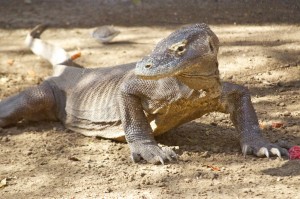 However, it was not a fruitless excursion. There are always some dragons which are lazier than others and wait in hope by the kitchens in the wardens’ camp. Here we found four dragons, two males and two females. These were not particularly healthy looking specimens; their ribs were clearly visible. The wardens do not feed them but the smell of food draws them to the kitchen in a forlorn hope that they might be fed. In the end hunger forces them to find food for themselves.
However, it was not a fruitless excursion. There are always some dragons which are lazier than others and wait in hope by the kitchens in the wardens’ camp. Here we found four dragons, two males and two females. These were not particularly healthy looking specimens; their ribs were clearly visible. The wardens do not feed them but the smell of food draws them to the kitchen in a forlorn hope that they might be fed. In the end hunger forces them to find food for themselves.
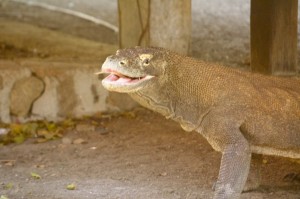 The wardens have to be very careful. These hungry dragons often hide underneath the stilted houses. As a result the wardens have to check before coming down the steps. There have been a number of attacks this year where wardens have fallen victim to a dragon hiding underneath the steps to their room.
The wardens have to be very careful. These hungry dragons often hide underneath the stilted houses. As a result the wardens have to check before coming down the steps. There have been a number of attacks this year where wardens have fallen victim to a dragon hiding underneath the steps to their room.
The good thing about having a number of dragons who are so attached to the kitchens is that they are easy to photograph. The wardens ensured that we kept a safe distance from them and warned us to move back if any began to approach. The wardens are armed with a forked staff, which presumably is the most effective way of keeping dragons at bay without causing them any harm, although I am sure that with one snap of their powerful jaws they could reduce the staff to matchsticks.
Returning to our boat, we set sail again to anchor off a beach where we could swim, snorkel and enjoy the warmth of the water and all that was within it. On the way we had a sumptuous lunch of rice, chicken, fish, tofu and vegetables followed with pineapple and watermelon. Having digested our meal the swimming was wonderful and the braver members of the group jumped or dived off the top of the boat, four or five metres above the surface of the water. Snorkelling was like swimming in a tropical fish tank. I spent time getting used to using my camera underwater. Using the waterproof case is brilliant but you have no way of knowing whether you are taking what you want. It is impossible to use the viewfinder and also to check each picture or video on the screen. It is very hit and miss and I found the best policy was to just click away in the hope that there would be something worth having. The colours and variety of fish was amazing and it was fantastic just to pick on a particular fish or shoal and follow it. They were unconcerned by our presence, unless we got too close, and continued uninterrupted in their quest for food. As they nibbled at the coral their chomping could be heard very clearly. Sadly, at this location most of the coral was dead.
As the afternoon drew on we set sail again for a mangrove swamp to watch the fruit bats at dusk as they rose from the mangrove to fly to the mainland for food. The Indonesians call them flying foxes. They are huge and in the course of about half an hour a million of them will rise from the swamp. Our boat was positioned so that it was beneath the flight path. While we waited we watched the spectacular sunset. Unfortunately, my photos of the flight do not do the event justice.
That night we slept on deck, under a myriad of stars. The cloudy haze of the Milky Way was clearly visible and shooting stars flew across the sky at various intervals. A light, cooling breeze fanned across our faces and made sleep more comfortable.
At 4.30am the engines chugged into life, the anchor was lifted and we headed off towards Komodo Island, a journey of about two and a half hours. Lying on deck, feeling the movement of the boat as it rode the water and watching the sky lighten in the east was a wonderful way to greet the new day.
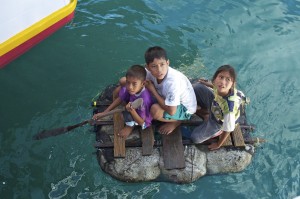 Anchoring off Komodo village we enjoyed breakfast. We were soon visited by children paddling out on makeshift rafts of polystyrene wrapped in discarded fishing net wanting to sell us trinket Komodo Dragons carved out of shells.
Anchoring off Komodo village we enjoyed breakfast. We were soon visited by children paddling out on makeshift rafts of polystyrene wrapped in discarded fishing net wanting to sell us trinket Komodo Dragons carved out of shells.
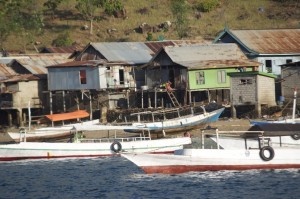 Komodo village is much larger than I expected. From the boat we could see stilted houses following the line of the shore. There were several rows of houses beyond. From our vantage point the houses seemed to be made mainly of wood with planks or woven reeds making up the walls with corrugated iron roofing. On the beach high bowed fishing boats were parked or were moored in the shallows. Dom Bosco told us that the population was about 1400. There were far more children than we were expecting.
Komodo village is much larger than I expected. From the boat we could see stilted houses following the line of the shore. There were several rows of houses beyond. From our vantage point the houses seemed to be made mainly of wood with planks or woven reeds making up the walls with corrugated iron roofing. On the beach high bowed fishing boats were parked or were moored in the shallows. Dom Bosco told us that the population was about 1400. There were far more children than we were expecting.
Whilst the group explored Komodo village, Jim and I met with the village head to discuss the toilet building programme. This took a long time. It was decided that we would try to get one toilet finished, leaving the other two for the villagers to build when the sites were prepared. We went to visit the first site at the far end of the village. It was just outside a house! I’m not sure I would want a public toilet within two feet of where I lived. There was much discussion between the village head and several other men as to positioning etc. With so much discussion I began to wonder if we would ever get started.
Eventually we got the green light and had to return to the other end of the village to collect all the building materials, gathering the group together to carry steel rods, lengths of timber, bags of cement and corrugated iron across the village to the building site. By the time we returned with the materials the men had marked out the dimensions and dug the foundations for the building.
It was always our intention to not only provide the funding for these toilets but also the labour force for the building of them. Things do not always work out as planned and the villagers seemed determined to do the work themselves while we watched. Some of the tools were a little unusual. For mixing the cement we only had one shovel so a short paddle was used. This gave Jim, as head of rowing, some ideas for the boat club. The rocks for the foundations were gathered from the beach, as was the sand for mixing with the cement. Occasionally we would try to become involved but whatever we were doing would be taken over by a local. It was becoming increasingly frustrating and as the day got hotter and hotter, standing around in the sun became less pleasant.
The work, or our presence, was generating a fair amount of interest in the village, particularly among the children, and soon we were surrounded by children craving our attention. The students enjoyed the attention and were happy to entertain the children in a variety of ways.
It became clear that we were probably not of much use and that we were wasting our time watching the construction process. When it came to lunchtime I suggested that we return to the boat, enjoy lunch, and then go to a beach/bay within easy reach for a cooling swim, to return to Komodo later in the day to witness the progress the men had made. This idea was approved by all and we returned to the boat, taking with us our entourage of children as far as the end of the jetty.
Instead of sailing off we stayed where we were and spent the afternoon playing in the water and diving off the boat. Everybody was gaining confidence, having done it once, and began to be more adventurous in their jumps and dives. We had individual dives, twists, turns and artistic impressions, sequence jumping and group plunges. It was great fun and a lovely way to spend the afternoon after some of the frustrations of the morning. The only disappointment was that Stephen lost his Gopro on a dive, it slipping off its anchorage to his wrist and sinking to the bottom in 21m of water. He tried diving but without success. Dom Bosco asked if any of the villagers could dive to that depth but their limit was about 16m. His camera would continue to take intermittent pictures from its watery grave until the battery ran out.
Children came out from the village in a dug out canoe to try to sell us their trinkets. They would come along side and climb out onto our boat. They were not very persistent with their sales but were happy to be in our company. Helen, being a kayaker, wanted a go in the dug out. She struggled to get in, the boat being extremely narrow, and balance was quite an issue. We all watched, expecting her to capsize, but she managed to stay afloat much to our disappointment.
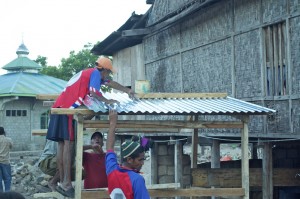 As the afternoon drew to a close we returned to the building site to see how the work was progressing. The framework was almost finished. As we watched the final pieces of the structure were nailed into place and the corrugated iron roof was hammered home. The children were again a distraction, following us wherever we went and demanding our full attention. All around the building site, hair was being plaited, songs and dances were being taught and some were given control of cameras to take pictures.
As the afternoon drew to a close we returned to the building site to see how the work was progressing. The framework was almost finished. As we watched the final pieces of the structure were nailed into place and the corrugated iron roof was hammered home. The children were again a distraction, following us wherever we went and demanding our full attention. All around the building site, hair was being plaited, songs and dances were being taught and some were given control of cameras to take pictures.
As the afternoon blended into evening the work stopped as the men, all muslim, needed to return home for their meal, having gone throughout the day without both food and water as they were fasting for Ramadan. We returned to the boat and sailed off for our night time anchorage away from the village.
The village of Komodo seems to have had a huge amount of input from all sorts of organisations in recent months. Wherever you go on Flores and on Komodo there are banners and posters advertising “Sail Komodo”. In September there will be sailing events and large cruise liners coming specifically to Komodo. In order to cater for such an influx of people, central government and various NGOs have invested heavily in Komodo. A new paved footpath is being created the length of the village and trees have been planted with protective fences around them. We counted at least fourteen new toilets, none of which seemed to be finished, and there were one hundred houses being built to replace houses that needed replacing. I knew none of this when we were looking for a project and while, at the time of planning, toilets and Komodo Dragons may well have been an issue, the development of Komodo village has moved ahead rapidly. What was not clear was whether this investment was for a one-off event or whether the impetus for improvement and development would be continued as the event was repeated year by year.
The following morning, having again slept on deck, we headed back towards Komodo Island but this time not to the village but to the national park for more Komodo Dragons. We docked our boat at the brand new, not yet used, quay big enough for ocean going cruise liners to dock at and obviously part of the “Sail Komodo” project. This suggests that the project is a long term concept and not just a one off event.
The walk was on similar terrain as Rinca but shorter in distance. Despite it being shorter, we saw a great deal more with sightings of deer, wild boar, parakeets and dragons, not just lingering around the kitchen area but out in the bush. It was fortunate that we were there early in the morning as dragons need to bask in the sunshine to bring their temperature up. Once it is up they tend to find shady areas to shelter from the sun and are therefore less easy to spot.
On top of Sulphur Hill we came across a pair, a male and a female, basking in the early morning sunshine. It was immediately noticeable how much more healthy these animals seemed. They were plumper and generally more alert and robust.
As we were nearing the end of our walk and returning to the centre via the beach two stags strolled down the beach looking very out of place in such an environment. More dragons were waiting near the buildings but unlike those on Rinca, these looked more healthy.
It was while photographing these that we noticed another dragon marching purposefully along the beach. Rushing down to see it it proved difficult to film and keep up with so I ran on ahead to photograph it from the front. Again I had to move quickly in order to get into a good position. Eventually I positioned myself by the old wooden jetty and started filming. The dragon continued with its determined stride along the beach but as it approached the jetty it turned towards me. The wardens became concerned and I had to retreat up the beach to make room and allow the dragon to go the route it wanted to take. On the other side of the jetty it disappeared into the trees at the top of the beach.
Returning to our boat for breakfast we sailed the short distance to Pink Beach, a favourite spot for snorkelling over the coral reef. It is called Pink Beach because of the slight pink hue the sand has when wet. It is made up of thousands of tiny shell particles and coral. Snorkelling here is a fabulous experience. I snorkelled here three years ago and my memory was of brilliant coloured coral and a huge variety of exotic fish. The exotic fish were there but the coral seemed much less colourful than I remember. Patches of it were dead or dying, and I don’t remember that. There were some splashes of colour but fewer than I remember. Certainly the camera seems to fail to pick up the colours, dulling them down.
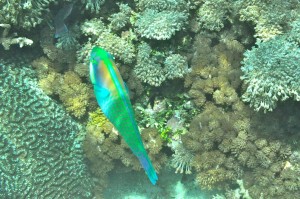 We spent the bulk of the morning exploring the coral and the best fish seemed to be closer to the headland where the rocks tumbled steeply into the sea. I could not tire of gently swimming around, watching the marine life beneath me, all within touching distance.
We spent the bulk of the morning exploring the coral and the best fish seemed to be closer to the headland where the rocks tumbled steeply into the sea. I could not tire of gently swimming around, watching the marine life beneath me, all within touching distance.
Having spent the morning at Pink Beach we sailed across to an island on the other side of a narrow gap of turbulent water to another island for lunch and for further swimming in the afternoon. We had arranged to return to Komodo village later in the afternoon to visit the school to distribute our gifts of stationary, toys, clothing etc. to the children. As there were far more children than we anticipated it had been agreed that we would give to particular age groups.
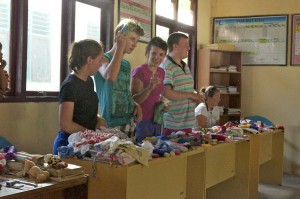 Typically, more children turned up than expected and what should have been a very enjoyable occasion turned into a chaotic shambles. It started off reasonably well. We were ushered into a classroom where we separated and laid out everything we had brought on to desks. It was an impressive array of items. It brought the nostalgic child out in the group members as they played with the toys, waiting for the next instruction in the proceedings. It became clear that while we were doing this the teachers were trying to organise the children into two groups.
Typically, more children turned up than expected and what should have been a very enjoyable occasion turned into a chaotic shambles. It started off reasonably well. We were ushered into a classroom where we separated and laid out everything we had brought on to desks. It was an impressive array of items. It brought the nostalgic child out in the group members as they played with the toys, waiting for the next instruction in the proceedings. It became clear that while we were doing this the teachers were trying to organise the children into two groups.
We were ushered into a second classroom where there was a group of 28 children. We sang a couple of songs, “If You’re Happy and You Know It” and “Heads, Shoulders, Knees and Toes”. The children sang a couple in return. While this was happening the teachers and Dom Bosco collected 28 items from the classroom for us to give one to each child. This worked reasonably well.
In the second classroom there were in excess of 60 children. Having gone through the song routine again the teachers brought in twenty items and selected twenty children to receive them. The remainder looked crestfallen, particularly when they were told they would get theirs the following morning. That is when the chaos started.
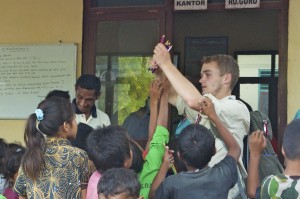 Eventually, to satisfy the children they were told to come to the classroom where the gifts were stored and they would receive them on the veranda to the room. Bedlam ensued with children pushing and shoving to get to the front. It was a sea of hands grabbing and pulling. One fight broke out. Many took one item, hid it and then put their hand out for another. Our students who were caught up in the melee found it very difficult and quite distressing. In the end I decided to pull everybody away and leave it to the teachers to sort out, teachers who seemed to have very little control in such situations.
Eventually, to satisfy the children they were told to come to the classroom where the gifts were stored and they would receive them on the veranda to the room. Bedlam ensued with children pushing and shoving to get to the front. It was a sea of hands grabbing and pulling. One fight broke out. Many took one item, hid it and then put their hand out for another. Our students who were caught up in the melee found it very difficult and quite distressing. In the end I decided to pull everybody away and leave it to the teachers to sort out, teachers who seemed to have very little control in such situations.
We now went to the other end of the village to inspect the progress on the toilet. The men had been busy all day and with the exception of the concrete lining to the tank behind the structure, it was finished. The pedestal was cemented in place and the outflow pipe had been connected. All the walls were complete. Behind the shed a pit had been dug, which is what had to be lined round the sides. The bottom of the pit would remain a bed of sand. The effluent would flow into the pit, become liquid and gradually filter through the sand. A concrete lid would be constructed to enclose the pit. Nothing could be simpler.
I was quite pleased when we left Komodo for the last time. En route to our night time mooring we stopped briefly. In that brief stop a dugout canoe came alongside selling wooden carved dragons. Jim was just contemplating buying one and was holding it to help his decision making when our boat chugged into life and set off across the bay, chased by two men frantically paddling their dugout in pursuit. It was remarkable how fast they could go in such a flimsy and unstable canoe but they stuck to the task and within a few minutes of us dropping anchor they were alongside again. Jim felt guilty and probably paid over the odds but felt they deserved it for the effort they had made to secure a sale.
The next day was pure fun. We sailed from sandy beach to sandy beach, taking time to swim in the clear waters, to marvel at the marine life and to become ever more daring in our attempts to dive or jump off the boat. Here is a selection of some of them with varying degrees of success.
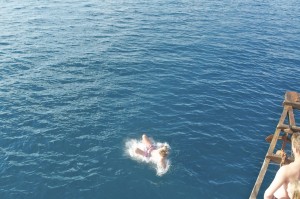
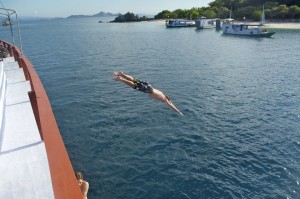
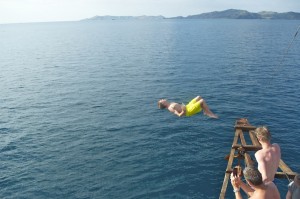
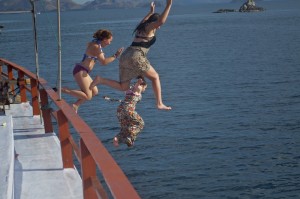
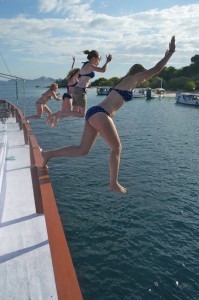 That night, back on dry land we enjoyed a meal in a restaurant overlooking the harbour before returning to the luxury of the Jayakarta Hotel, although it should be mentioned that after four days and three nights on a boat, it was difficult to stop the room from rocking gently from side to side.
That night, back on dry land we enjoyed a meal in a restaurant overlooking the harbour before returning to the luxury of the Jayakarta Hotel, although it should be mentioned that after four days and three nights on a boat, it was difficult to stop the room from rocking gently from side to side.
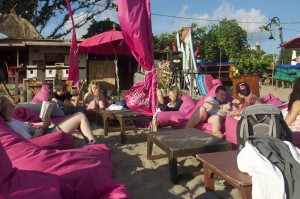 The following day we flew back to Bali for a couple of nights with retail therapy high on the agenda. It was a relaxing way to end a very active, multi faceted trip, although it became a little tiresome fending off the very persistent street sellers. The group responded well to the environment, avoided the pitfalls that Bali presents and enjoyed the opportunity to relax. Our last evening was spent on the beach. Stephen arranged for us to go to Double Six, a beach with surfing opportunities but also a relaxed beach bar atmosphere where bean bags were supplied from which to enjoy our last Indonesian sunset.
The following day we flew back to Bali for a couple of nights with retail therapy high on the agenda. It was a relaxing way to end a very active, multi faceted trip, although it became a little tiresome fending off the very persistent street sellers. The group responded well to the environment, avoided the pitfalls that Bali presents and enjoyed the opportunity to relax. Our last evening was spent on the beach. Stephen arranged for us to go to Double Six, a beach with surfing opportunities but also a relaxed beach bar atmosphere where bean bags were supplied from which to enjoy our last Indonesian sunset.
To conclude, I would just like to say how enjoyable the students made this trip, They were a pleasure to be with and very easy to look after. They cared for each other and were a credit to all concerned, parents, school and themselves. I cannot finish without mentioning my colleagues, Jim, Helen, Magda and Ellie, without whom none of this would have been possible. I feel it was a fitting end to my twenty years of running the Himalayan Club at King’s and look forward to helping Josh Hand and watching him take the Himalayan Club into its third decade.

